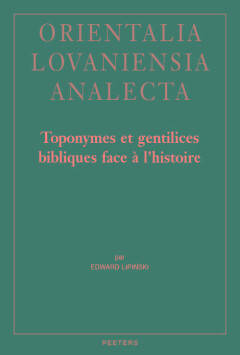
Je cadeautjes zeker op tijd in huis hebben voor de feestdagen? Kom langs in onze winkels en vind het perfecte geschenk!
- Afhalen na 1 uur in een winkel met voorraad
- Gratis thuislevering in België vanaf € 30
- Ruim aanbod met 7 miljoen producten
Je cadeautjes zeker op tijd in huis hebben voor de feestdagen? Kom langs in onze winkels en vind het perfecte geschenk!
- Afhalen na 1 uur in een winkel met voorraad
- Gratis thuislevering in België vanaf € 30
- Ruim aanbod met 7 miljoen producten
Zoeken
Omschrijving
English summary: This book aims to identify various biblical place names and gentilices, mostly outside of Canaan, and to situate them within the historical context of which they are generally deprived in the Bible. These names often appear in lists, which can also contain names of important characters, mixed with place names. The successive chapters thus review the lists of "Sons of Canaan," "Sons of Misraim," "Sons of Aram," "Sons of Abraham and Keturah," "Sons of Ishmael," "Sons of Cush," and "Sons of Joktan," generally located in Yemen. The visit of the Queen of Sheba falls within this framework. The origin of Zebulun and Naphtali is examined, as well as the meaning or location of the toponyms Bethlehem, Teman, Tema, Hagar, etc. The use of the names Tanis, Hanes, Sais and Phut in the Bible is reviewed. The original text of the note on the assassination of Sennacherib and the accounts relating to the Moabite capital are then reconstituted in light of the Septuagint version. One chapter is devoted to the figures of Gog/Gyges and Tugdamme/Lygdamis, while another deals with the regions of northern Mesopotamia, whose names are distorted in the Bible; it is the land of Shupriya, Kulimmer and Izal. Then come the islands of Ulysses, Kub and Pul, which is Apulia, while Lachish and its Yaho-Roi sanctuary are the subject of the last chapter. The work notes several tiqquney soferim dating from the end of the Persian period or the Hellenistic period. It is completed with several indexes. French description: Ce livre vise a identifier divers toponymes et gentilices bibliques, en majorite exterieurs au Canaan, et a les situer dans un contexte historique dont ils sont generalement prives dans la Bible. Ils apparaissent souvent dans des listes, qui peuvent aussi contenir des noms de personnages importants, meles a des noms de lieu. Les chapitres successifs passent ainsi en revue les listes de "Fils de Canaan", de "Fils de Misrayim", de "Fils d'Aram", de "Fils d'Abraham et de Qetura", de "Fils d'Ismael", de "Fils de Kush", de "Fils de Yoqtan", localises generalement au Yemen. La visite de la reine de Saba s'inscrit dans ce cadre. L'origine de Zabulon et de Nephtali est ensuite examinee, ainsi que le sens ou la localisation des toponymes Bethleem, Teman, Tema, Hagar, etc. L'usage des noms de Tanis, Hanes, Sais et Put dans la Bible est ensuite passe en revue. Le texte original de la notice sur l'assassinat de Sennacherib et des recits relatifs a la capitale moabite est ensuite reconstitue a la lumiere de la version des Septante. Un chapitre est consacre aux figures de Gog/Gyges et de Tugdamme/Lygdamis, tandis qu'un autre traite des regions de la Mesopotamie septentrionale, dont le nom est defigure dans la Bible; il s'agit du pays de Shupriya, de Kulimmer et d'Izal. Viennent ensuite les Iles d'Ulysse, Kub et Pul, qui est l'Apulie, tandis que Lakish et son sanctuaire de Yaho-Roi font l'objet du dernier chapitre. L'ouvrage releve plusieurs tiqqune soferim datables de la fin de l'epoque perse ou de la periode hellenistique. Il est complete de plusieurs indexes.
Specificaties
Betrokkenen
- Auteur(s):
- Uitgeverij:
Inhoud
- Aantal bladzijden:
- 253
- Taal:
- Frans
- Reeks:
- Reeksnummer:
- nr. 267
Eigenschappen
- Productcode (EAN):
- 9789042935389
- Verschijningsdatum:
- 27/02/2018
- Uitvoering:
- Hardcover
- Formaat:
- Genaaid
- Gewicht:
- 1846 g

Alleen bij Standaard Boekhandel
+ 194 punten op je klantenkaart van Standaard Boekhandel
Beoordelingen
We publiceren alleen reviews die voldoen aan de voorwaarden voor reviews. Bekijk onze voorwaarden voor reviews.









